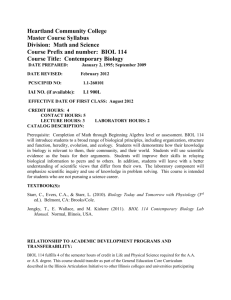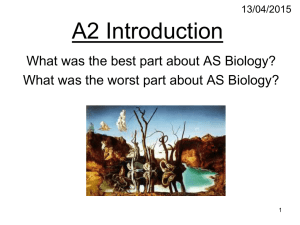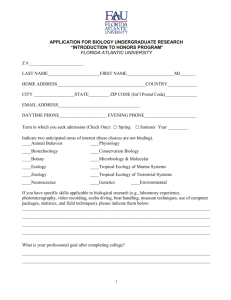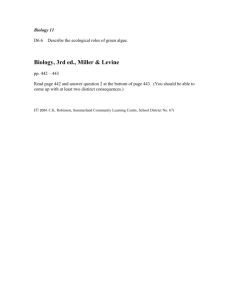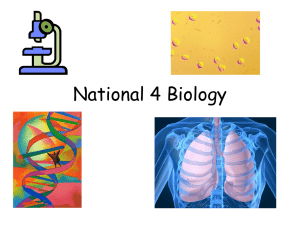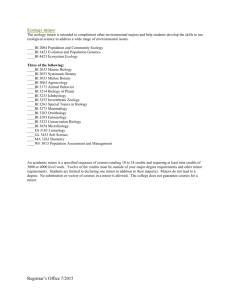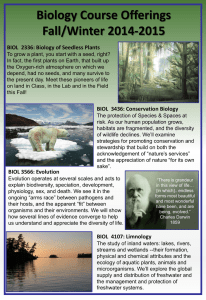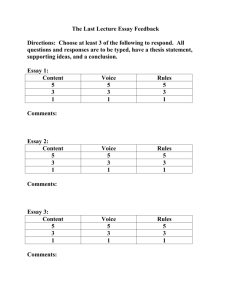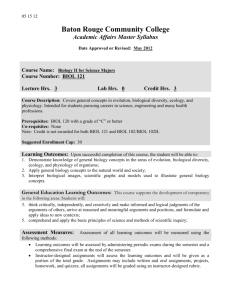BIOL 1620 Sample Syllabus
advertisement
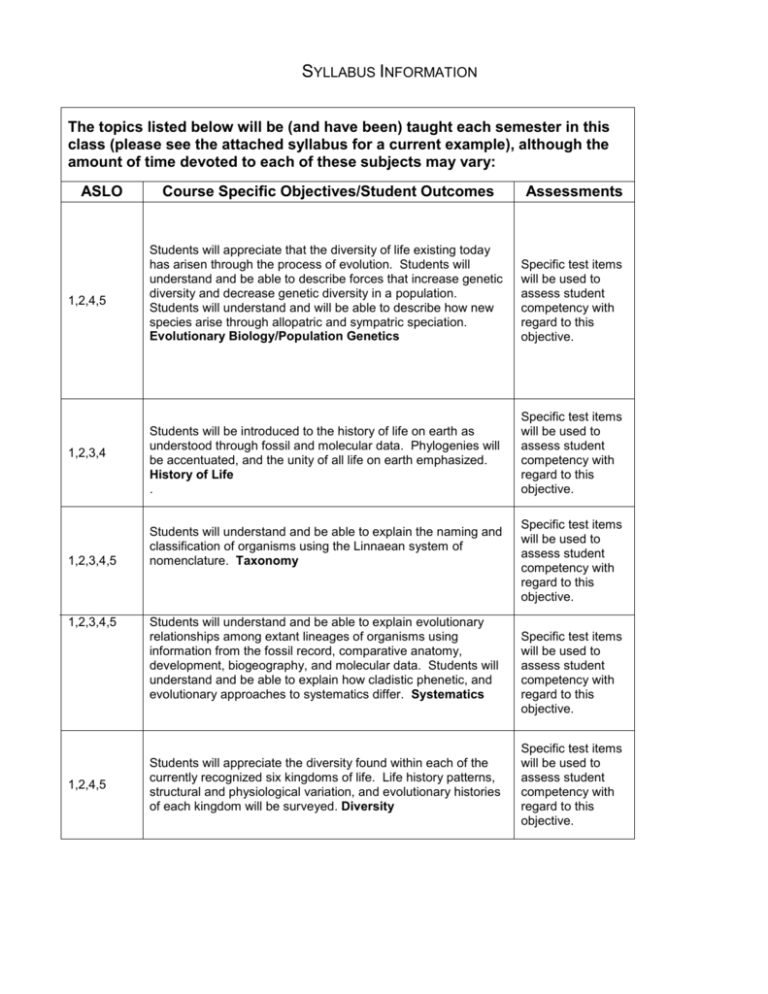
SYLLABUS INFORMATION The topics listed below will be (and have been) taught each semester in this class (please see the attached syllabus for a current example), although the amount of time devoted to each of these subjects may vary: ASLO 1,2,4,5 1,2,3,4 1,2,3,4,5 1,2,3,4,5 1,2,4,5 Course Specific Objectives/Student Outcomes Assessments Students will appreciate that the diversity of life existing today has arisen through the process of evolution. Students will understand and be able to describe forces that increase genetic diversity and decrease genetic diversity in a population. Students will understand and will be able to describe how new species arise through allopatric and sympatric speciation. Evolutionary Biology/Population Genetics Specific test items will be used to assess student competency with regard to this objective. Students will be introduced to the history of life on earth as understood through fossil and molecular data. Phylogenies will be accentuated, and the unity of all life on earth emphasized. History of Life . Specific test items will be used to assess student competency with regard to this objective. Students will understand and be able to explain the naming and classification of organisms using the Linnaean system of nomenclature. Taxonomy Students will understand and be able to explain evolutionary relationships among extant lineages of organisms using information from the fossil record, comparative anatomy, development, biogeography, and molecular data. Students will understand and be able to explain how cladistic phenetic, and evolutionary approaches to systematics differ. Systematics Students will appreciate the diversity found within each of the currently recognized six kingdoms of life. Life history patterns, structural and physiological variation, and evolutionary histories of each kingdom will be surveyed. Diversity Specific test items will be used to assess student competency with regard to this objective. Specific test items will be used to assess student competency with regard to this objective. Specific test items will be used to assess student competency with regard to this objective. 1,2,3,4 1.2,3,4,5 1,2,3,4,5 1,2,3,4,5 1,2,3,4,5 Students will understand and be able to describe the structure and function of a “typical” plant. Structural and reproductive variation in plants will be surveyed. Plant Biology Specific test items will be used to assess student competency with regard to this objective. Students will understand and be able to describe the variation in anatomy and physiology found within the animal kingdom. Animal Biology Specific test items will be used to assess student competency with regard to this objective. Students will be able to describe how members of populations interact. Population Ecology Students will understand and be able to discuss how members of different populations interact by competition, predation, and symbiosis. Students will be able to describe a species’ niche within a community, and how communities change through succession. Community Ecology Students will appreciate the diversity of ecosystems present on earth. Ecosystems Specific test items will be used to assess student competency with regard to this objective. Specific test items will be used to assess student competency with regard to this objective. Specific test items will be used to assess student competency with regard to this objective. Process Objectives/Learning Outcomes ASLO A person educated in biology courses should: 1,2,3,4,5 1,4,5 1) Understand, value and use science as a process of obtaining knowledge based upon observable evidence. 2) Understand that human beings are living organisms dependent for survival and quality of life on the biological and physical natural world. Assessments Understanding and use of scientific process will be assessed by monitoring and scoring student laboratory work. A combination of multiple choice, short answer and essay questions will be included as assessment items on examinations. A combination of multiple choice, short 2,4,5 3) Appreciate the historical development and cumulative nature of science. 4,5 4) Understand the relationships and differences between science and technology. answer and essay questions will be included as assessment items on examinations. Student use of technology in the laboratory will be assessed and monitored. 1,2,4,5 5) Recognize science as an achievement of human civilization that enables us to understand and appreciate the natural world. 1,2,4 6) Distinguish between science and pseudoscience. 1,2,4,5 7) Understand and accept the social and ethical responsibilities of scientific knowledge. 1,2,3,4 8) Understand essential principles, concepts and appropriate terminology of science. Student writing assignments will be assessed to monitor understanding and appreciation of scientific achievement A combination of multiple choice, short answer and essay questions will be included as assessment items on examinations. Student writing assignments will be assessed to monitor understanding and appreciation of social and ethical responsibilities A combination of multiple choice, short answer and essay questions will be included as assessment items on examinations. Content Objectives/Learning Outcomes A person educated in the life sciences should ASLO have an understanding of these essential concepts: 1,2,3,4,5 9) Principles and applications of the scientific method. 1,2,5 10) The chemical and physical nature of life and the applicability of physical laws. 1,2,5 11) The patterns and processes of evolution and the resulting diversity of life. 1,2,5 12) The inheritance and continuity of life (genetics and reproduction). 1,2,5 13) Structure, function, and development at the molecular, cellular, and organismal levels. 1,2,5 14) The interactions of organisms with each other and with their environment. 1,2,5 15) The consequences of interactions between humans and the biosphere. Assessments Understanding and use of scientific method will be assessed by monitoring and scoring student laboratory work. A combination of multiple choice, short answer and essay questions will be included as assessment items on lecture and laboratory assessments. A combination of multiple choice, short answer and essay questions will be included as assessment items on lecture and laboratory assessments. A combination of multiple choice, short answer and essay questions will be included as assessment items on lecture and laboratory assessments. A combination of multiple choice, short answer and essay questions will be included as assessment items on lecture and laboratory assessments. A combination of multiple choice, short answer and essay questions will be included as assessment items on lecture and laboratory assessments. Student writing assignments will be assessed to monitor understanding and appreciation of social and ethical responsibilities Delivery Format(s): This class has both lecture (three hours per week) and laboratory (3 hours per week) components. Student performance in the lecture portion of this course will be assessed using exams and/or quizzes. Exams and quizzes use question formats appropriate to the subject matter, including (but not limited to): multiple choice, matching, short answer, labeled diagrams, and essay. It is an expectation of this course that students will express themselves (on exams) using proper grammar and spelling. Laboratory performance will be assessed on the basis of lab participation, lab quizzes, and a laboratory writing assignment. The laboratory score constitutes twenty percent of the student’s final grade. Instructions on Specific Assignments and Processes: Methodologies utilized in this class include: lecture, readings in the textbook, and laboratory work. Lectures, where possible, will be coordinated with laboratories. Reading assignments are coordinated with lectures. Students are expected to attend each lecture and take notes during the entire period. If appropriate, the class may meet in other settings. Reading assignments in the course textbook are provided to broaden the base of information provided to students. It is the expectation that students will preview appropriate chapters before being lectured, and will read for depth following the lecture on each topic. The instructor typically provides a textbook study guide with study questions and appropriate vocabulary for each assigned chapter. Students are also encouraged to take advantage of online study materials provided by the textbook publisher. Students are expected to attend and participate in laboratory each week. Students should read the lab manual prior to lab, so as to use their limited time in lab to full advantage. Laboratory methodologies will vary from week to week, depending upon the nature of the laboratory exercise, but will include both individual and collaborative efforts. The laboratory includes both quantitative and qualitative exercises. Students may be asked to write a laboratory paper that utilizes both library and internet sources. Appendix A Sample Syllabus BIOL 1620 (College Biology II) - PROPOSED SYLLABUS Biol 1620 is an introductory biology class that is intended for all students who wish to major in Biology at SLCC. Students who successfully complete the Biology 1610/1620 (College Biology I/II) course sequence at SLCC will be able to transfer their credit to any school in the Utah State system that also offers a Biology I/II sequence. Topics covered include population genetics, speciation, evolutionary process, history of life, taxonomy and systematics, life cycles, ecology and a kingdom by kingdom survey of the diversity of life Students are expected to attend three hours of lecture and one three hour laboratory (Biol 1625) per week. Additional time should be anticipated to complete assigned readings in the text (or other assignments) and prepare for quizzes/exams. Please note the following information: 1. Lecturer: William Tanner Office: SI 329 Phone: 957-4792 email: william.tanner@slcc.edu Office Hour: M-F 1-1:50 2. Text: Solomon et al – BIOLOGY 3. Grading: Performance will be evaluated on the basis of three one-hour exams, a two-hour comprehensive final exam, and your lab score. Each exam and the final will be valued at 100 points, and the lab score will also be expressed as a percent with a possible total of 100 points. The possible point total for this course will therefore be 500 points. The test schedule and grading scale are give below. TEST SCHEDULE GRADING SCALE Test 1 – End of Week 5 Test 2 – End of Week 10 Test 3 – End of Week 15 Comprehensive Final Final Exam Week 4. Attendance: 462 - 500 = A 450 - 461 = A437 - 449 = B+ 412 - 436 = B 400 - 411 = B387 - 399 = C+ 362 - 386 = C 350 - 361 = C337 - 349 = D+ 312 - 336 = D 300 - 311 = D<300 = E Attendance of lectures is expected of all students. Please come to class on time, prepared to take notes during the entire fifty minute lecture period. 5. Biology Laboratory: Concurrent enrollment in Biol 1625 is required of Biol 1620 students. Note: Your lab scores make up twenty percent of your grade. 6. Holidays: This class does not meet during Spring/Fall break or State and Federal Holidays. 7. Study Time: Students should anticipate spending one to two hours each day doing assigned reading and learning lecture material. 8. Last Day to Withdraw: xx/xx/xx. Please make note of this date. Withdrawals after this date are only permitted for extraordinary situations (see college catalogue for specifics). 9. Cell Phones/Pagers: Please turn off during class. 10. Policy on Cheating: Cheating will result in an E for the course. LECTURE SCHEDULE Week Chapter/Topic 1 1-2 2 2 3 3 4 5 5 22) Descent with Modification: A Darwinian View of Life (review) 23) The Evolution of Populations (review) 24) The Origin of Species 25) Phylogeny and Systematics 26) The Tree of Life: An Introduction to Biological Diversity 27) Prokaryotes 28) Protists 29) Plant Diversity I: How Plants Colonized the Land 30) Plant Diversity II: The Evolution of Seed Plants 6 7 7 7 8 8 Test 1 31) Fungi 32) An Introduction to Animal Diversity 33) Invertebrates 34) Vertebrates 35) Plant Structure, Growth, and Development 36) Transport in Vascular Plants 9 9 9 37) Plant Nutrition 38) Angiosperm Reproduction and Biotechnology (in part) 39) Plant Responses to Internal and External Signals (in part) Test 2 10 10 10 11 11 11 12 12 12 12 13 13 13 14 15 40) Basic Principles of Animal Form and Function 41) Animal Nutrition (in part) 42) Circulation and Gas Exchange (in part) 43) The Immune System (in part) 44) Osmoregulation and Excretion (in part) 45) Hormones and the Endocrine System (in part) 46) Animal Reproduction (in part) 47) Animal Development (in part) 48) Nervous Systgems (in part) 49) Sensory and Motor Mechanisms (in part) 50) An Introduction to Ecology and the Biosphere 51) Behavioral Ecology 52) Population Ecology 53) Community Ecology 54) Ecosystems Test 3 Comprehensive Final Exam Please Note: Students with disabilities needing accommodations, please contact me and/or the Disability Resource Center in the College Center.
